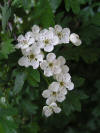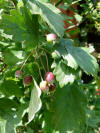


_small.jpg)

WILD
FOODIES' HOME PAGE
PLANT PROFILE LIST
NAME: Hawthorn
SPECIES / FAMILY: Crataegus Monogyna / Rosaceae (many other species)
OTHER COMMON NAME(S):
CONDITIONS:
sun-partial shade
|
PARTS: |
EDIBLE |
TASTE |
RAW/COOK |
SEASON |
|
All |
|
|
|
|
|
Shoots |
|
|
|
|
|
Leaves |
|
DRY4TEA |
Spring-Summer |
|
|
Stalk/Stem |
|
|
|
|
|
Buds |
||||
|
Flowers |
|
|
|
|
|
Fruits |
|
sweet/sour |
RAW/DRY/COOK |
Aug-Jan |
|
Pods |
|
|||
|
Seeds |
|
|
|
|
|
Nuts |
|
|
|
|
|
Roots |
|
|
|
|
|
Bark |
|
|
|
|
PORTION: medium
COMMENT: There are many different species, colors, and sizes of Hawthorns. Not all Hawthorns have thorns, but all of the fruit has a crown. Fruit used to make jelly, fruit leather/roll-up, or as pectin for other fruit jams. // Can be made into a sauce for cooking, or used to flavor alcohols, just ripe berries have more pectin than over-ripe berries.(2) Fruit - is normally used for making jams and preserves. The fruit can be dried, ground, mixed with flour and used for making bread etc. A tea is made from the dried leaves, it is a china tea substitute.(1) Very young spring leaves ó called Bread and Cheese ó can be a trail side nibble as well as the flower buds or young flowers.(2)
CAUTION: Do NOT eat seeds! They contain cyanide bonded with sugar, called amygdalin. In your gut ó actually small intestine ó that changes to hydrogen cyanide and can be deadly. You can cook the berries then discard the seeds, but donít eat the seeds.If an adult mistakenly eats one or two seeds they arenít deadly but they could be to a child. Mature flowers should be avoided or any part that smells like almonds when crushed.(2)
NUTRITION/MEDICINAL: Antispasmodic; Astringent; Cardiotonic; Diuretic; Hypotensive; Sedative; Tonic; Vasodilator.(1) https://www.webmd.com/vitamins/ai/ingredientmono-527/hawthorn
LOOK-A-LIKES:
POISONOUS LOOK-A-LIKES:
OTHER USES: Wood - very hard and tough, difficult to work. Used for tool handles etc. Valued in turning. A good fuel, giving out a lot of heat.(1)
SOURCE LINKS (may include nutritional and medicinal info, plus other uses):